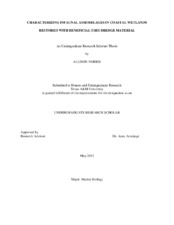| dc.description.abstract | Wetlands are important to the coastal environment because of the variety of purposes they serve to the area wildlife. The ecological and economic importance of wetlands makes it imperative to understand the benefits of different wetland restoration processes. Many wetland bird species forage in unvegetated areas called mudflats, yet these mudflats are rarely included in wetland restoration design. One method used for wetland restoration is known as Beneficial Uses Method. This restoration process involves using dredge material to create a continuous area of wetlands. Beneficial Uses Method can include different procedures that create small variation in elevation, soil moisture, and the amount of vegetation. These variations may increase the number and diversity of birds using the restored area. My objective was to compare populations of birds, and the small, mud-dwelling animals (infauna) that they eat, among planted, unplanted + high elevation (dry), and unplanted + low elevation (wet) areas of a restored coastal marsh near Port Arthur, TX. I hypothesized that unplanted, wet areas would have the most infauna, and would therefore support more birds. Replicate cores were taken from each habitat type, sieved, and infauna were identified to the lowest taxonomic group possible. To monitor bird use, game cameras were deployed in each habitat type and programmed to take pictures every 30 minutes and also when motion was present. The pictures were later analyzed and birds were identified to species. Unplanted areas had 109 times more infaunal density than planted areas. Wet unplanted areas had 68 times more infaunal density than dry unplanted areas. Likewise, birds were most frequently observed in wet, unplanted areas. The most common birds in wet areas were ibis, herons, egrets, and ducks. When restoring wetlands, including areas that are wet and unplanted is important for providing habitat for the infauna that will support residential and migratory bird populations. | en |


